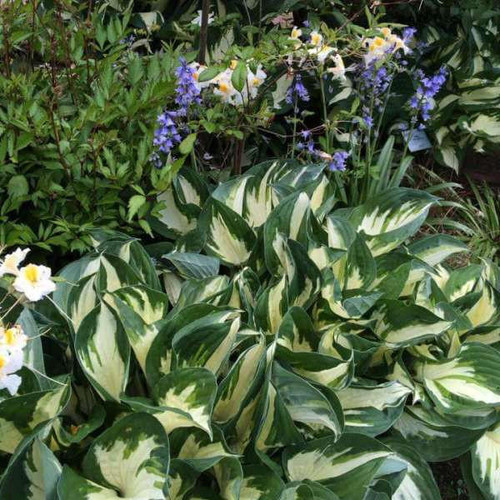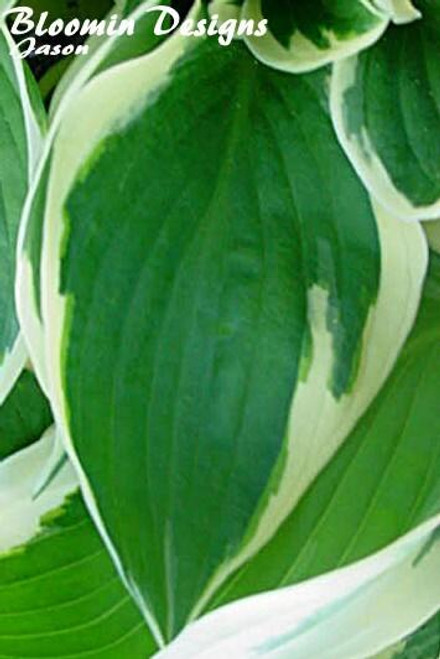Product Description
'Fire Island' Hosta (4) 1-gallons
Small - Medium.
Brilliant yellow, intensely wavy, broadly ovate leaves and light red petioles with red coloration extending into leaf base.
Mature size about 14 inches high and 34 inches wide, mound-like with fast growth rate.
Lavender flowers.
In shade, leaves may change to chartreuse through the season, and red petioles throughout the season.
Parent: longipes hypoglauca x CRESTED SURF.
Hosta 'Fire Island' is a vibrant and captivating hosta that brings a burst of sunshine to shady gardens. This small to medium-sized hosta features brilliant gold, heart-shaped foliage that emerges in spring with a fiery intensity. The leaves are thick and slightly corrugated, with distinctly rippled margins, adding a lovely texture to the display. As the season progresses, the foliage matures to a softer chartreuse-yellow, but the red petioles (leaf stalks) remain a striking feature throughout the growing season, adding further visual interest. In midsummer, 'Fire Island' produces delicate lavender flowers that rise above the foliage on tall scapes, completing the show.
- Mature Size: 10-14 inches tall, 15-30 inches wide
- Leaf Size: 4-6 inches long, 3-4 inches wide
- Flower Color: Lavender
- Bloom Time: Midsummer
- Growth Habit: Mounding
- Sunlight: Partial Shade to Full Shade
- Soil: Moist, well-drained
- Hardiness Zones: 3-8
Planting and Care:
- Planting: Choose a location with partial shade to full shade. 'Fire Island' thrives in shady conditions and will maintain its vibrant color best without excessive direct sunlight. Ensure the soil is moist and well-drained. Amend the soil with compost or other organic matter before planting. Dig a hole slightly larger than the root ball and plant at the same depth as the container. Space plants about 18-24 inches apart to allow for their mature spread.
- Watering: Keep the soil consistently moist, especially during dry periods. Water at the base of the plant to avoid wetting1the leaves, which can increase the risk of fungal diseases.
- Fertilizing: Apply a balanced fertilizer in early spring as new growth emerges. Avoid over-fertilizing.
- Mulching: Mulch around the plants with shredded bark, compost, or pine needles to retain moisture, control weeds, and protect the crown.
- Pest and Disease Control: Be vigilant for slugs and snails, which can be a threat to hostas, although 'Fire Island' is somewhat resistant due to its thick leaves. Use appropriate control measures like slug bait or traps if needed. Hosta Virus X (HVX) is also a potential issue; purchase plants from reputable sources and discard any plants exhibiting symptoms of the virus.
- Division: Divide clumps every 3-5 years, or as needed, to prevent overcrowding and rejuvenate the plant. Division is best done in spring or fall.
Special Considerations:
- Hosta 'Fire Island' is an excellent choice for brightening up shady borders, woodland gardens, or container plantings.
- Its vibrant gold foliage and contrasting red petioles add a touch of fire to shady spots.
- It pairs well with other shade-loving plants, especially those with contrasting foliage colors and textures.
- This hosta is known for its vigorous growth and is relatively easy to care for, making it a great choice for gardeners of all levels.
(4) 1-gallon containers ready to plant, plants may be trimmed for shipping,
Other Details
The most important part of the plant is its root system. Healthy roots are the foundation of a healthy, vibrant plant. The type of plug container used is based on the specific needs of the plants. Perennials offered as bare root traditionally perform better when planted as bare root.Planted in a specialized mix, potted plants have well established root systems. Top growth stage will vary depending on the current life cycle and time of year when shipped. In Winter and early Spring dormant plants may be shipped. Dormant plants may be planted right away, even before the last frost date.
Most bare root varieties are field grown for at least one season, though Hemerocallis and Hosta are grown for two seasons. The bulk of the soil is removed during the harvesting process and the tops of most varieties are trimmed back to the crown. They are graded, packed in shredded aspen or sphagnum moss and stored in freezers until ready to be shipped.
See our Container Sizes and Bare Root Perennials pages for more information.
Plant information and care is provided in the Overview section, Plant Genus Page and general information is provided in the Planting Care & Guides. Additional questions can be asked on each Plant page.
Plant Spacing: Using the maximum mature spread or width of a plant to guide spacing, ensures space to grow to full size. To fill an area sooner, plant them closer together. Just remember, future thinning or transplanting may be needed.
Water: Keep a close eye on newly planted perennials, especially throughout the first growing year. Most early plant loss is due to too much or too little water!


















